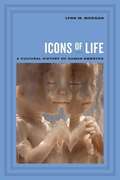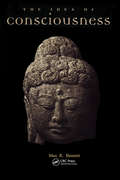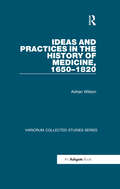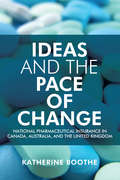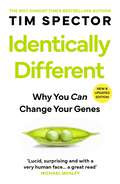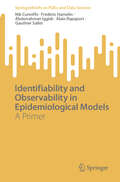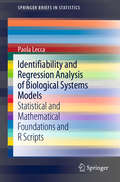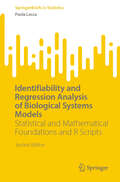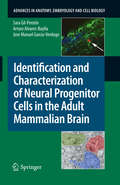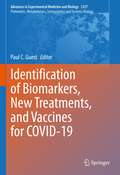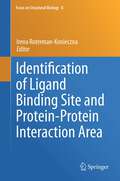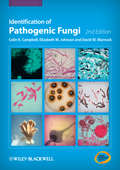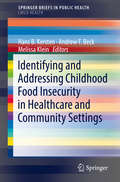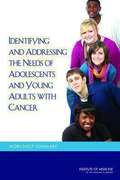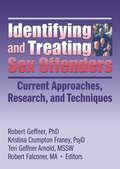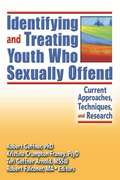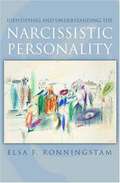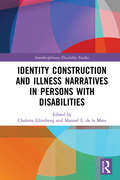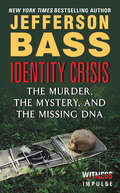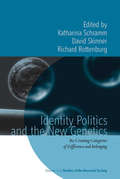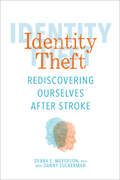- Table View
- List View
Icons of Life: A Cultural History of Human Embryos
by Lynn M. MorganThis book takes up the question of how embryos-- as ideas, images, symbols, and tiny bits of human tissue-- are generated, circulated, and enlivened by social and political discourse and shows how embryological view of development intersects with the social and material history of human embryo collecting.
Idea of Consciousness: Synapses and the Mind
by Max R. BennettThe Idea of Consciousness examines the problem of how the working of synaptic connections might give rise to consciousness, and describes the current neuroscientific concepts and techniques used to identify and explore those parts of the brain that may be involved. This book will serve as an invaluable and stimulating introduction to the subject. Beautifully illustrated, it is a must for anyone who is curious about consciousness.
Ideas and Practices in the History of Medicine, 1650–1820 (Variorum Collected Studies #1038)
by Adrian WilsonAlthough articles in this volume fall into three thematic clusters, each of those groups exemplifies three general themes: micro-social processes; innovations and the question of continuity versus discontinuity; and the relationship between ideas and practice. Most of these essays touch upon, and some of them are exclusively concerned with, small scale social processes: e.g. the routines of the all-female early-modern childbirth ritual, the different ways that male practitioners were summoned to such occasions, the functioning of voluntary hospitals, the protocols underlying patient records. Such social practices are well worth studying as both the sites and drivers of larger-scale historical change. Whenever there comes into being something new - whether an institution (a hospital), a social practice (the summoning of men as midwives) or a concept (a new approach to disease) - the question arises as to its relationship with what went before. This concept resonates throughout these essays, but is most to the fore in the chapters on early Hanoverian London (which asks explanatory questions) and on Porter versus Foucault (who represent the extremes of continuity and discontinuity respectively). A couple of generations ago, the ’history of ideas’ was pursued largely without reference to practice; in recent times, the danger has appeared of the very reverse taking place. This book ranges across a broad spectrum in this respect, the emphasis being sometimes upon practice (Eleanor Willughby’s work as a midwife) and sometimes upon ideas (concepts of pleurisy across the centuries); but in every case there is at least the potential for relating the two to one another. None of these themes is specific to medical history; on the contrary, they are the bread-and-butter of historical reconstruction in general.
Ideas and the Pace of Change
by Katherine BootheCanada is the only OECD country that has universal, comprehensive public hospital and medical insurance but lacks equivalent pharmaceutical coverage. In Ideas and the Pace of Change, Katherine Boothe explains the reasons for this unique situation. Using archival, interview, and polling data, Boothe compares the policy histories of Canada, the United Kingdom, and Australia in order to understand why Canada followed a different path on pharmaceutical insurance.Boothe argues that pace matters in policy change. Quick, radical change requires centralized political institutions, an elite consensus, and an engaged, attentive electorate. Without these prerequisites, states are far more likely to take a slower, incremental approach. But while rapid policy change reinforces the new consensus, incremental progress strengthens the status quo, letting development stall and raising the bar for achieving change.An important contribution to the study of comparative political economy, Ideas and the Pace of Change should be required reading for anyone seeking to understand why health care reforms succeed or fail.
Identically Different: Why You Can Change Your Genes
by Professor Tim Spector'This is not simply a book of ideas, it is also a book of stories, most astounding, many heartbreaking' - Bryan Appleyard, SUNDAY TIMESSince the discovery of DNA, scientists have believed that genes are fixed entities that cannot be changed by environment - we inherit them, pass them on to our children and take them with us when we die.Professor Tim Spector reveals how the latest genetic research and his own pioneering studies on epigenetics are rewriting everything we thought we knew about genes, identity and evolution. Conceptually, he explains, our genes are not fixed entities but more like plastic, able to change shape and evolve, and these changes can be passed on to future generations.Tim Spector's dazzling guide to the hidden world of our genes reveals the complex role they play in shaping our identities, and will make you think again about everything from sexuality to religion, cancer to autism, politics to pubic hair, clones to bacteria, and what it is that makes us all so unique and quintessentially human.
Identically Different: Why You Can Change Your Genes
by Professor Tim Spector'This is not simply a book of ideas, it is also a book of stories, most astounding, many heartbreaking' - Bryan Appleyard, SUNDAY TIMESSince the discovery of DNA, scientists have believed that genes are fixed entities that cannot be changed by environment - we inherit them, pass them on to our children and take them with us when we die.Professor Tim Spector reveals how the latest genetic research and his own pioneering studies on epigenetics are rewriting everything we thought we knew about genes, identity and evolution. Conceptually, he explains, our genes are not fixed entities but more like plastic, able to change shape and evolve, and these changes can be passed on to future generations.Tim Spector's dazzling guide to the hidden world of our genes reveals the complex role they play in shaping our identities, and will make you think again about everything from sexuality to religion, cancer to autism, politics to pubic hair, clones to bacteria, and what it is that makes us all so unique and quintessentially human.
Identically Different: Why You Can Change Your Genes
by Tim Spector'This is not simply a book of ideas, it is also a book of stories, most astounding, many heartbreaking' - Bryan Appleyard, SUNDAY TIMESSince the discovery of DNA, scientists have believed that genes are fixed entities that cannot be changed by environment - we inherit them, pass them on to our children and take them with us when we die.Professor Tim Spector reveals how the latest genetic research and his own pioneering studies on epigenetics are rewriting everything we thought we knew about genes, identity and evolution. Conceptually, he explains, our genes are not fixed entities but more like plastic, able to change shape and evolve, and these changes can be passed on to future generations.Tim Spector's dazzling guide to the hidden world of our genes reveals the complex role they play in shaping our identities, and will make you think again about everything from sexuality to religion, cancer to autism, politics to pubic hair, clones to bacteria, and what it is that makes us all so unique and quintessentially human.
Identifiability and Observability in Epidemiological Models: A Primer (SpringerBriefs on PDEs and Data Science)
by Alain Rapaport Nik Cunniffe Frédéric Hamelin Abderrahman Iggidr Gauthier SalletThis book introduces the concepts of identifiability and observability in mathematical epidemiology, as well as those of observers’ constructions. It first exposes and illustrates on several examples the mathematical definitions and properties of observability and identifiability. A chapter is dedicated to the well-known Kermack McKendrick model, for which the complete analysis of identifiability and observability is not available in the literature. Then, several techniques of observer constructions, in view of online estimation of state and parameters, are presented and deployed on several models. New developments relevant for applications in epidemiology are also given. Finally, practical considerations are discussed with data and numerical simulations related to models previously analysed in the book. The book will be appealing to epidemiological modellers and mathematicians working on models in epidemiology.This book contributes to Sustainable Development Goal 3 (SDG3): Good Health and Well Being.
Identifiability and Regression Analysis of Biological Systems Models: Statistical and Mathematical Foundations and R Scripts (SpringerBriefs in Statistics)
by Paola LeccaThis richly illustrated book presents the objectives of, and the latest techniques for, the identifiability analysis and standard and robust regression analysis of complex dynamical models. The book first provides a definition of complexity in dynamic systems by introducing readers to the concepts of system size, density of interactions, stiff dynamics, and hybrid nature of determination. In turn, it presents the mathematical foundations of and algorithmic procedures for model structural and practical identifiability analysis, multilinear and non-linear regression analysis, and best predictor selection.Although the main fields of application discussed in the book are biochemistry and systems biology, the methodologies described can also be employed in other disciplines such as physics and the environmental sciences. Readers will learn how to deal with problems such as determining the identifiability conditions, searching for an identifiable model, and conducting their own regression analysis and diagnostics without supervision. Featuring a wealth of real-world examples, exercises, and codes in R, the book addresses the needs of doctoral students and researchers in bioinformatics, bioengineering, systems biology, biophysics, biochemistry, the environmental sciences and experimental physics. Readers should be familiar with the fundamentals of probability and statistics (as provided in first-year university courses) and a basic grasp of R.
Identifiability and Regression Analysis of Biological Systems Models: Statistical and Mathematical Foundations and R Scripts (SpringerBriefs in Statistics)
by Paola LeccaThis richly illustrated book presents the latest techniques for the identifiability analysis and standard and robust regression analysis of complex dynamical models, and looks at their objectives. It begins by providing a definition of complexity in dynamic systems, introducing the concepts of system size, density of interactions, stiff dynamics, and the hybrid nature of determination. The discussion then turns to the mathematical foundations of model structural and practical identifiability analysis, multilinear and non-linear regression analysis, and best predictor selection, and their algorithmic procedures. Although the featured examples mainly focus on applications to biochemistry and systems biology, the methodologies described can also be employed in other disciplines such as physics and the environmental sciences. Readers will learn how to determine identifiability conditions, how to search for an identifiable model, and how to conduct their own regression analysis and diagnostics without supervision. This new edition includes a concise, yet comprehensive treatment of the main artificial intelligence methods which can be used for parameter inference in models of complex dynamic biological systems. It emphasizes the most efficient solutions for generating synthetic data that augment the training data and which are indispensable for machine learning procedures. Featuring a wealth of real-world examples, exercises, and R codes, the book addresses the needs of doctoral students and researchers in bioinformatics, bioengineering, systems biology, biophysics, biochemistry, the environmental sciences and experimental physics. Familiarity with the fundamentals of probability and statistics (as provided in first-year university courses) and a basic grasp of R are assumed.
Identification and Characterization of Neural Progenitor Cells in the Adult Mammalian Brain
by Sara Gil-Perotín Jose Manuel Garcia-Verdugo Arturo Alvarez-BuyllaAdult neurogenesis has been questioned for many years. In the early 1900s, a dogma was established that denied new neuron formation in the adult brain. In the last century however, new discoveries have demonstrated the real existence of proliferation in the adult brain, and in the last decade, these studies led to the identification of neural stem cells in mammals. Adult neural stem cells are undifferentiated cells that are present in the adult brain and are capable of dividing and differentiating into glia and new neurons. Newly formed neurons terminally differentiate into mature neurons in the olfactory bulb and the dentate gyrus of the hippocampus. Since then, a number of new research lines have emerged whose common objective is the phenotypical and molecular characterization of brain stem cells. As a result, new therapies are successfully being applied to animal models for certain neurodegenerative diseases or stroke. At present, and in years to come, this finding extends to the adult human brain, and gives reason and hope to all the previous studies.
Identification of Biomarkers, New Treatments, and Vaccines for COVID-19 (Advances in Experimental Medicine and Biology #1327)
by Paul C. GuestThe novel coronavirus 2019 (COVID-19) has caused a serious global pandemic in just one year. Nearly every country and territory in the world has been affected by the virus. The virulence and infection rate of the virus are profound, and has required extreme social distancing measures across the globe in order to prevent overwhelming the healthcare services and hospitals. COVID-19 appears to have the greatest effects on elderly individuals and those who have co-morbid diseases, such as diabetes and obesity. As the cases and death rate remain high, there are justified fears of this virus remaining for several months or years to come. To address this, a rapid and unprecedented worldwide mobilization effort has begun to identify effective treatments and develop vaccines. As these begin to be deployed and administered across the globe, many now feel the virus will be brought under control and lives will eventually return to normal. This new volume will increase readers’ understanding of the ongoing COVID-19 pandemic through a series of chapters that address these concerns. Leading experts will discuss new treatment approaches, vaccine development, mental health aspects of the pandemic, and convey the results of survey studies. The book will be an excellent resource for researchers studying virology, metabolic diseases, respiratory disorders, and clinical scientists, physicians, drug companies, and healthcare services and workers.
Identification of Ligand Binding Site and Protein-Protein Interaction Area
by Irena Roterman-KoniecznaThis volume presents a review of the latest numerical techniques used to identify ligand binding and protein complexation sites. It should be noted that there are many other theoretical studies devoted to predicting the activity of specific proteins and that useful protein data can be found in numerous databases. The aim of advanced computational techniques is to identify the active sites in specific proteins and moreover to suggest a generalized mechanism by which such protein-ligand (or protein-protein) interactions can be effected. Developing such tools is not an easy task - it requires extensive expertise in the area of molecular biology as well as a firm grasp of numerical modeling methods. Thus, it is often viewed as a prime candidate for interdisciplinary research.
Identification of Pathogenic Fungi
by Elizabeth M. Johnson Colin K. Campbell David W. WarnockSince the first edition of Identification of Pathogenic Fungi, there has been incredible progress in the diagnosis, treatment and prevention of fungal diseases: new methods of diagnosis have been introduced, and new antifungal agents have been licensed for use. However, these developments have been offset by the emergence of resistance to several classes of drugs, and an increase in infections caused by fungi with innate resistance to one or more classes.Identification of Pathogenic Fungi, Second Edition, assists in the identification of over 100 of the most significant organisms of medical importance. Each chapter is arranged so that the descriptions for similar organisms may be found on adjacent pages. Differential diagnosis details are given for each organism on the basis of both colonial appearance and microscopic characteristics for the organisms described.In this fully updated second edition, a new chapter on the identification of fungi in histopathological sections and smears has been added, while colour illustrations of cultures and microscopic structures have been included, and high quality, four colour digital images are incorporated throughout.
Identifying Future Disease Hot Spots: Infectious Disease Vulnerability Index
by Paul Christopher Melinda Moore Adeyemi Okunogbe Bill GelfeldRecent high-profile outbreaks such as Ebola and Zika have illustrated the transnational nature of infectious diseases. Countries that are most vulnerable to outbreaks may be higher priorities for technical support. RAND's Infectious Disease Vulnerability Index should help U.S. government and international agencies identify these countries and inform programming to preemptively mitigate the spread and effects of potential transnational outbreaks.
Identifying and Addressing Childhood Food Insecurity in Healthcare and Community Settings (SpringerBriefs in Public Health)
by Hans B. Kersten Andrew F. Beck Melissa KleinThis salient resource offers clinicians a comprehensive multi-tiered framework for identifying, addressing, and reducing food insecurity among children and their families. Reinforcing the importance of food insecurity as a key social determinant of health, this monograph reviews the epidemiology and presents in-depth guidelines for screening for food insecurity and hunger. Recommendations for screening in a busy clinical setting as well as the strengths and limitations of widely-used instruments are discussed. The monograph also outlines a variety of clinic-level interventions, potential community-based resources, and opportunities for clinical-community partnerships to improve families’ food access and security. Further, contributors provide workable plans for large-scale advocacy through greater engagement with professional and community resources as well as policymakers. The monograph concludes with an outline of the critical steps to implement a food insecurity screening process and the key components to train the next generation of provider-advocates. Included in the coverage: Epidemiology and pathophysiology of food insecurity Screening tools and training Scope of interventions to address food insecurity Creation and evaluation of the impact of food insecurity-focused clinical-community partnerships on patients and populations Development of an action plan to fight food insecurityIdentifying and Addressing Childhood Food Insecurity in Healthcare and Community Settings will find an engaged audience among physicians and other clinicians who want to address food insecurity in their healthcare and/or community setting. Institutions that are starting to address social determinants of health, including food insecurity, will find guidance on screening tools, processes and evaluation of impact.
Identifying and Addressing the Needs of Adolescents and Young Adults with Cancer
by Sharyl J. Nass"Identifying and Addressing the Needs of Adolescents and Young Adults with Cancer" is the summary of a workshop convened by the Institute of Medicine's National Cancer Policy Forum in July 2013 to facilitate discussion about gaps and challenges in caring for adolescent and young adult cancer patients and potential strategies and actions to improve the quality of their care. The workshop featured invited presentations from clinicians and other advocates working to improve the care and outcomes for the adolescent and young adult population with cancer. Cancer is the leading disease-related cause of death in adolescents and young adults. Each year nearly 70,000 people between the ages of 15 and 39 are diagnosed with cancer, approximately 8 times more than children under age 15. This population faces a variety of unique short- and long-term health and psychosocial issues, such as difficulty reentering school, the workforce, or the dating scene; problems with infertility; cardiac, pulmonary, or other treatment repercussions; and secondary malignancies. Survivors are also at increased risk for psychiatric conditions such as anxiety, depression, substance abuse, and suicide and may have difficulty acquiring health insurance and paying for needed care. "Identifying and Addressing the Needs of Adolescents and Young Adults with Cancer" discusses a variety of topics important to adolescent and young adult patients with cancer, including the ways in which cancers affecting this group differ from cancers in other age groups and what that implies about the best treatments for these cancer patients. This report identifies gaps and challenges in providing optimal care to adolescent and young adult patients with cancer and to discuss potential strategies and actions to address them.
Identifying and Treating Sex Offenders: Current Approaches, Research, and Techniques
by Robert Geffner Kristina Crumpton Franey Teri Geffner Arnold Robert FalconerGain a better understanding of the behaviors of sex offenders to create effective interventions! Identifying and Treating Sex Offenders: Current Approaches, Research, and Techniques brings you up-to-date on the latest significant issues and state-of-the-art tools involved in the evaluation and treatment of adult sex offenders. This book pr
Identifying and Treating Youth Who Sexually Offend: Current Approaches, Techniques, and Research
by Kristina Crumpton FraneyWhat factors contribute to the making of a youthful sexual offender?This book is designed to assist professionals working with youth who sexually offend. A distinguished panel of experts discusses the latest research and provides theory, techniques, and practical guidelines for the assessment and treatment of this challenging population. Identifying and Treating Youth Who Sexually Offend: Current Approaches, Techniques, and Research lays an essential foundation with a theoretical overview that frames the subject in a clear, easy-to-follow style. This section includes: a comprehensive overview of the controversies, definitions, and salient characteristics of youth who sexually offend that that provides an understanding of the factors believed to be related to sex offending among youth as well as an up-to-date review of current theory an examination of an etiological model that is frequently applied to adult sex offenders-is it applicable for use with youthful offenders?The second section of Identifying and Treating Youth Who Sexually Offend tackles the challenges professionals face when conducting assessments of sexually abusive youth. This section is designed to help the clinicians of today and tomorrow become better equipped to handle the daunting task of assessment-from choosing assessment tools to decreasing denial with specific interviewing techniques. Readers will learn: how to distinguish subtypes among this population-with a research review and comparative descriptions of clinical and empirical typologies as well as discussion of the Trauma Outcome Process model and practical examples for clinicians how to predict the rate of re-offense among youth who sexually offend, with a review of five risk assessment methods and four scales plus directions for using them-includes the Juvenile Sex Offender Assessment Protocol (JSOAP), the Protective Factors Scale (PFS), and the Estimate of Risk of Adolescent Sex Offender Recidivism (ERASOR) the "nuts and bolts" of the interviewing and clinical assessment phase of treatment-a look at effective interviewing strategies, the process of change, and the stages of change model the importance of family therapy in the treatment of these youth-ways to include parents in relapse prevention planning and ways to handle treatment providers&’ misconceptions and concerns about including family therapy in this type of treatment cognitive-behavioral treatment models for use in outpatient settings-with treatment strategies directed toward various individual or family clinical targets, including psychological dysfunctions, sexual deviance, adolescent development and adaptive skills, and parent/family relationships an integrated (holistic) experiential approach to treatment, complete with sample exercises and a discussion of the pros and cons of many current treatment modalities a multi-family group therapy (MFGT) approach-with a look at this powerful intervention mode&’s advantages, including economic benefits, family-to-family support and mentoring, community-based resourcefulness, and accelerated catalyzing of emotions, and directions for how to establish a MFGT format for treatment current practices in residential treatment for adolescent sex offenders-policies, testing and assessment procedures, therapeutic approaches used, number of males and females in treatment, etc.The final section of Identifying and Treating Youth Who Sexually Offend explores what happens to youth who sexually offend after they leave treatment. This includes: a survey of the literature on recidivism an evaluation of the effectiveness of treatment of 644 juvenile sex offenders through the meta-analysis of 10 studies-with encouraging results! a look at the life experiences of a samp
Identifying and Understanding the Narcissistic Personality
by Elsa F. RonningstamNarcissists have been much maligned, but according to clinicians who study personality, there are many productive narcissists who succeed spectacularly well in life because they can articulate a vision and make others follow. Elsa Ronningstam, who has been studying and treating narcissists for 20 years, presents a balanced, comprehensive, and up-to-date review of our understanding of narcissistic personality disorder, explaining the range from personality trait, which can be productive, to full-blown disorder, which can be highly destructive. Through fascinating case histories, Ronningstam shows us the inner life of narcissists, the tug of war that exists within them between self-confidence and arrogance on the one hand and painful shame and insecurity on the other. It is the first integrated clinical and empirical guide to assist clinicians in their work with narcissistic patients.
Identity Construction and Illness Narratives in Persons with Disabilities (Interdisciplinary Disability Studies)
by Chalotte GlintborgThis book investigates how being diagnosed with various disabilities impacts on identity. Once diagnosed with a disability, there is a risk that this label can become the primary status both for the person diagnosed as well as for their family. This reification of the diagnosis can be oppressive because it subjugates humanity in such a way that everything a person does can be interpreted as linked to their disability. Drawing on narrative approaches to identity in psychology and social sciences, the bio-psycho-social model and a holistic approach to disabilities, the chapters in this book understand disability as constructed in discourse, as negotiated among speaking subjects in social contexts, and as emergent. By doing so, they amplify voices that may have otherwise remained silent and use storytelling as a way of communicating the participants' realities to provide a more in-depth understanding of their point of view. This book will be of interest to all scholars and students of disability studies, sociology, medical humanities, disability research methods, narrative theory, and rehabilitation studies.
Identity Crisis
by Jefferson BassRenowned forensic anthropologist Bill Bass--founder of the Body Farm--tackles one of his most baffling cases ever in this real-life spellbinder In 1978, 56-year-old Leoma Patterson left a bar in Clinton, Tennessee, and was never seen again. Six months later, a female skeleton was found on a wooded lakeshore in a neighboring county. The bones were consistent with those of the missing woman, and one of Patterson's daughters recognized a ring found at the death scene as her mother's. The bones were buried, and six years later, a relative of Patterson's--one of the men she was last seen alive with--confessed to killing her. Case closed.But the tentative identification--made years before DNA testing was available to confirm it--failed to convince some of Patterson's relatives. And so it was that in 2005 Dr. Bass found himself winding around hairpin curves to the mountainside grave, where he would unearth the disputed remains and collect DNA samples. The forensic twists and turns that followed would test the limits of DNA technology ... and of Dr. Bass's half-century of forensic knowledge.
Identity Politics And The New Genetics
by David Skinner Richard Rottenburg Katharina SchrammRacial and ethnic categories have appeared in recent scientific work in novel ways and in relation to a variety of disciplines: medicine, forensics, population genetics and also developments in popular genealogy. Once again, biology is foregrounded in the discussion of human identity. Of particular importance is the preoccupation with origins and personal discovery and the increasing use of racial and ethnic categories in social policy. This new genetic knowledge, expressed in technology and practice, has the potential to disrupt how race and ethnicity are debated, managed and lived. As such, this volume investigates the ways in which existing social categories are both maintained and transformed at the intersection of the natural (sciences) and the cultural (politics). The contributors include medical researchers, anthropologists, historians of science and sociologists of race relations; together, they explore the new and challenging landscape where biology becomes the stuff of identity.
Identity Theft: Rediscovering Ourselves After Stroke
by Debra Meyerson Danny ZuckermanWinner of the 2019 Silver Nautilus Book Award, Identity Theft centers on Debra&’s experience: her stroke, her extraordinary efforts to recover, and her journey to redefine herself. But she also draws on her skills as a social scientist, sharing stories from several dozen fellow survivors, family members, friends, colleagues, therapists, and doctors she has met and interviewed. By sharing this diversity of experiences, Debra highlights how every person is different, every stroke is different, and every recovery is different. She provides a valuable look at the broad possibilities for successfully navigating the challenging physical recovery—and the equally difficult emotional journey toward rebuilding one&’s identity and a rewarding life after a trauma like stroke.
Identity Unknown: The gripping new Kay Scarpetta thriller for 2024 (Kay Scarpetta #30)
by Patricia CornwellTHE THRILLING NEW KAY SCARPETTA MYSTERY FROM THE WORLDWIDE BESTSELLER'Iconic. Bold. Brilliant. Identity Unknown is hauntingly original, impossibly clever and devilishly daring. Scalpel-sharp storytelling, trademark twists and characters that feel like family, this series is one of the all-time greats' CHRIS WHITAKER, author of Sunday Times bestseller All the Colours of the DarkSummoned to an unnerving, abandoned theme park to retrieve a body, Dr Kay Scarpetta is devastated to learn that the victim is a man she once loved. While teaching in Rome during the early days of her career, Scarpetta had a love affair with acclaimed astrophysicist Sal Giordano that led to a lifelong friendship.The murder scene is bizarre, with a crop circle of petals around the body, and Giordano's skin is strangely red. Scarpetta's niece Lucy believes he was dropped from an unidentified flying craft. Scarpetta knows an autopsy can reveal the dead's secrets, but she is shocked to find her friend seems to have deliberately left her a clue.As the investigators are torn between suspicions of otherworldly forces, and of Giordano himself, Scarpetta detects an explanation closer to home that, in her mind, is far more evil . . .DISCOVER THE SERIES THAT SHAPED THE WORLD OF CRIME FICTION'One of the best crime writers writing today' Guardian'Thirty years on, there's still no other crime writer like her' Sunday Times'Forget the pretenders. Cornwell reigns' Mirror'In a league of her own' Heat
